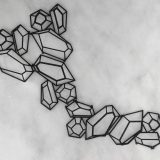Works

Marta Alaminos Cacace
May 18, 2021
María Camba
May 18, 2021
The project developed during iAtelier: Parenchyma
It is a project focused on the creation of jewellery pieces and accessories through polyhedral three-dimensional structures printed in 3D together with a specific design packaging according to each piece and material. Marta Alaminos and Chama Navarro shared skills and techniques and improved their ability with digital drawing programs. Parenchyma is the result of combining 3D printing with electroforming processes for copper covering jewellery and CNC router and laser cutting for the packaging.
Check the video of iAtelier workshop here!
Meet the maker
My name is Rosa Navarro, although you will find me as Chama Navarro, and my atelier is located in Madrid, Spain.
I studied Business and Economics and a master’s degree in graphic design and digital communication and worked for a few years in the field of marketing and advertising. I left it to train and work in the IT field as a systems and network technician. After a few years in the technology sector, I got to know the glass work and decided to change my profession again because I was seduced by the idea of working directly with fire, without intermediaries. For 15 years now I have been training and working with glass creating jewellery pieces with different techniques. During this time, I have trained as a jeweller with courses in schools and with masters, and self-taught. My life is a continuous research phase that never ends.
At the same time, I have taught to pass on my knowledge in the fields I know, from digital training for craftsmen, to working with glass or jewellery techniques.
What interested you in the iAtelier programme and did it meet with your expectations?
As a designer and innovative craftswoman, I believe that the combination of design and craftsmanship is nowadays essential for the progress and adaptation of the crafts sector to the demands of society. This programme interested me for that reason, being able to combine technology and craftsmanship with the help of expert professionals while minimising study and experimentation time was a great opportunity to launch myself into digital fabrication, which was on my long list of to-dos.
How will participating in iAtelier influence your future practice?
It has already had an influence. A great field has opened up for me in terms of tools, design, making processes, knowledge of new production processes and direct production in my workshop. I already have prototypes for my first collection of 3D printed jewellery, and I have projects underway to train interested people by combining technology and craftsmanship.
It has also made me more impatient with traditional production that requires more time in the process phases, as opposed to the immediacy of “draw and print”.
My 5 top tips that I have learnt on this journey
1.To be able to work well with technology you have to study. Having perseverance and patience when you study is fundamental to be able to be more agile when it comes to making quick tests and experimenting.
2. Machines are relatively simple compared to our complex brains, do not be afraid of them. They do what we tell them to do, so learning to talk to them is a necessary step.
3. Know what others are doing. If you observe, you will see that there are people who have been experimenting for a long time and do very complex things, so you will be able to do simple things with good results and you will not get discouraged. It is a path that you must walk little by little.
4. Age does not matter, there is always time to learn new things if you are interested.
5. Ask what you do not know and teach what you discover. Do not be afraid to work in a team, to ask the experts or to recognise that you do not know much about many things. We have moved beyond Pythagoras, we are no longer in the Middle Ages, so the transmission of knowledge is accepted and important in our today’s society.











